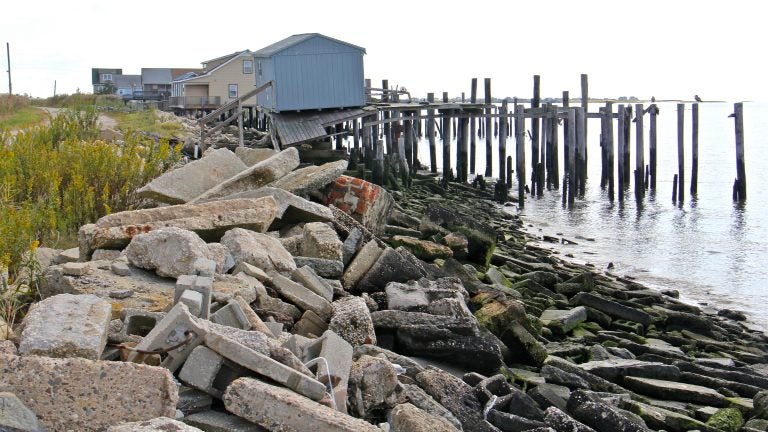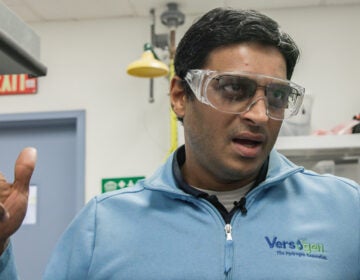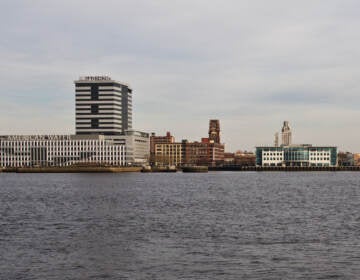As sea levels rise, Philly and Camden are at risk of being inundated with raw sewage, study finds
With climate-related flood risk rising, cities are confronting outdated sewer systems that could result in sewage backing up into basements and streets.
Listen 1:18
As climate-related flood risk rises, cities are confronting outdated sewer systems that could result in sewage backing up into basements and streets. (Emma Lee/WHYY)
From Philly and the Pa. suburbs to South Jersey and Delaware, what would you like WHYY News to cover? Let us know!
As climate change continues to ramp up wet weather events, cities like Philadelphia, Camden, and New York will increasingly face a messy problem — the eruption of raw sewage into people’s basements and in the streets.
That’s according to a recent study by a group of Drexel researchers, who used modeling techniques to predict how changing precipitation patterns and rising sea levels would affect flooding in Camden — providing a clue to how similar cities may fare as climate change continues to advance.
Combined sewer systems
Camden — along with other older coastal cities, including Philadelphia — is especially vulnerable because it uses a combined sewer system, which uses the same pipes to convey both sewage and stormwater. Normally, the combined flow goes to water treatment plants — but that changes during wet weather events.
“What happens often during large rainstorms is that there’s not enough capacity in the pipe,” said Franco Montalto, a civil engineering professor at Drexel who led the research. “The pipe can’t convey as much water to the treatment plant.”
At this point, structures called regulators come into play.
“Imagine the regulator as a switch, and when the water level is below a certain point, the switch is directing all the flow to the wastewater treatment plant,” Montalto said. “But when the flow exceeds that level, then the switch allows the water to go to two places. There’s still water that goes to the wastewater treatment plant, but then there’s an overflow that goes directly into a river.”
This is a problem from an ecological point of view, because that overflow includes untreated sewage. In the 1990s, the Environmental Protection Agency began requiring communities with combined sewer systems to develop long-term plans to reduce the dumping of untreated runoff, known as combined sewer overflows (CSOs).
The effects of sea level rise
When combined sewer systems are functioning the way they’re designed, CSOs — although damaging to the environment — keep sewage away from residents.
But that’s started to change in recent years thanks to the rise in sea levels.
“Whenever the combined sewer overflow pipes were built, ideally they were built above the mean high water,” Montalto said, “high enough so that water can discharge even at high tide. But if climate change is raising high tide, it becomes harder and harder for that water to exit this combined sewer pipe.”
When water levels are high enough, it becomes harder for the CSO flap gates — the relief points for overflow — to open, causing the overflow to back up into the sewer system.
“And water’s going to still find a way out,” Montalto said. “It might pop up through catch basins or through manholes, and you might see something that looks like a geyser in the street with sewage kind of spewing up in the street. It might back up into sewer traps in people’s basements.”
Modeling the future
Where this kind of sewage backup takes place depends on many factors, including proximity to CSOs, the slope of the ground, where intense rainfall is concentrated, and infrastructure design.
“Everywhere, whenever precipitation increases and coastal water levels increase, you’re going to have this kind of a problem,” Montalto said. “The severity of the problem depends on local conditions. You may have certain places where the sewer pipes are high enough or they’re big enough, where you have more of a sort of buffering capability than others. But I would say in any city, if you’re in a flat coastal plain adjacent to a water body that is rising because of sea level rise, then flooding is likely to get worse to some extent.”
Montalto and his team were able to generate detailed predictions through a collaboration with the Camden County Municipal Utilities Authority (CCMUA), which provided the researchers with detailed sewer maps. Using those maps, the team generated simulations of what would happen under various circumstances — looking both at potential increased precipitation and sea level rise scenarios, and what would happen if the CCMUA either did nothing, or enacted solutions to mitigate flooding.
One solution that their models supported is called the Pennsauken disconnection — a plan to divert stormwater originating in Pennsauken away from Camden, and specifically away from Cramer Hill, a neighborhood that’s historically been a frequent victim of flooding.
“And we showed that no matter what kind of climate changes you might have, whether it’s increases in precipitation only, increases in sea level only, a combination of increases in precipitation and increases in sea level, the Pennsauken disconnection makes sense,” Montalto said. “It reduces both flooding and sewer overflows. So it’s one of those sort of multifunctional infrastructure strategies that we are looking for as we try to address the multiple problems that face our cities.”
Montalto said his team plans to continue working with CCMUA to come up with alternative solutions, looking at both the benefits and the cost.
“What I think is really exciting and inspirational is that CCMUA, through its executive director, Scott Schreiber, has made the decision that he wants to simulate the cost effectiveness of these scenarios considering climate change,” Montalto said. “So he wants to look at future conditions. A lot of times, people and decision makers might just say, ‘Well, what has historically happened?’ And then they make the decision that is most cost-effective given historical conditions. And what Scott is saying is, ‘No, I don’t want to do that. I want to look at these future conditions because we’re building this infrastructure for long-term benefit, right? We want the benefits to accrue over years. So why would we want to build something that’s undersized given what the future is?'”

Get daily updates from WHYY News!
WHYY is your source for fact-based, in-depth journalism and information. As a nonprofit organization, we rely on financial support from readers like you. Please give today.







